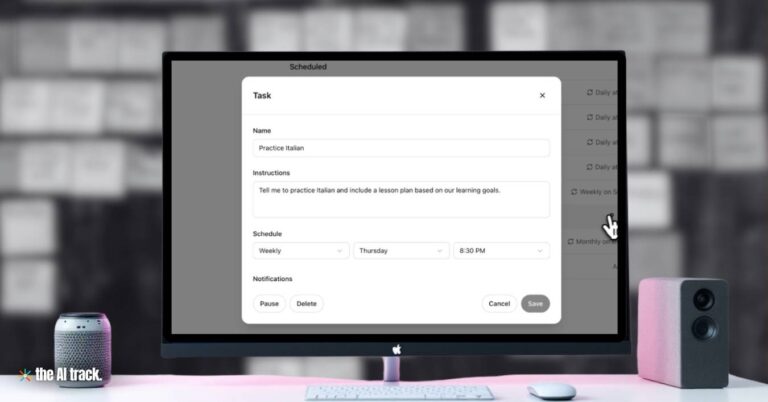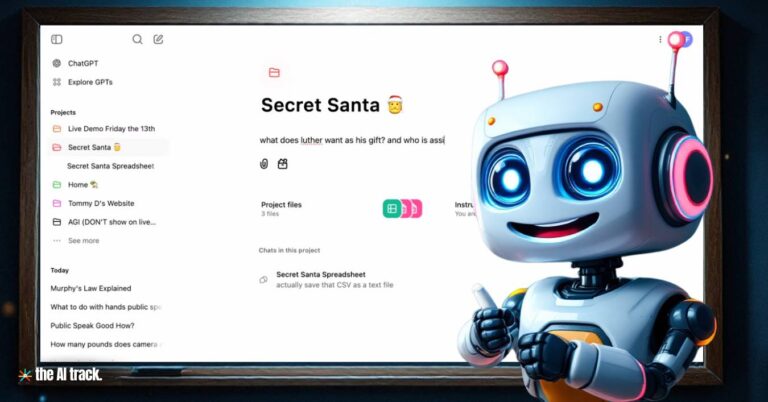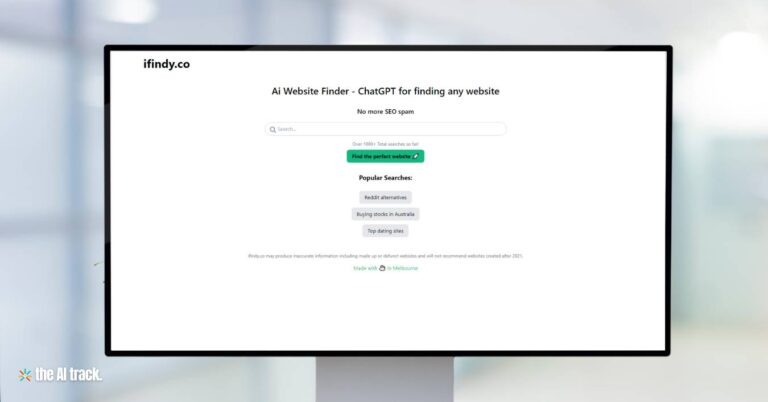Jump to Sections
The Uses of Artificial Intelligence
The uses of artificial intelligence have moved from the realm of science fiction into our everyday lives. But for many people, the world of AI still seems complex and inaccessible. The good news is that getting started with AI doesn’t require advanced technical skills or expensive tools. There are many free and user-friendly AI applications that anyone can use right away to improve their life and work.
This beginner’s guide will give you 9 practical uses of artificial intelligence, using only free tools that don’t have a steep learning curve. Consider this your AI 101 crash course – an easy introduction to integrating the uses of artificial intelligence into your daily activities. From AI writing assistants to virtual therapy chats, you’ll discover hands-on examples of how everyday uses of artificial intelligence can enhance your productivity, creativity, knowledge and more.
These uses of artificial intelligence starter ideas are just a launchpad – with no coding or complex math required. You can take the principles and personalize them to your own needs and interests. By the end, you’ll have a basic framework for making the uses of artificial intelligence work for you. Your own AI exploration and comprehension can flourish from there. So read on to demystify the uses of artificial intelligence and uncover its amazing potential to improve your life.

Enhancing Writing Skills with AI
What:
AI chatbots are primarily language models that can assist you in improving your writing style and clarity, rephrasing complex sentences and passages, checking for errors, providing guidance for your desired writing style, and adjusting the tone of a text. They can also help you shorten or lengthen a piece of text.
Area of Use:
Text is ubiquitous, found in various forms across our daily lives. Whether it’s casual email exchanges, texting, professional or academic writing, or content creation, AI chatbots can enhance or improve your writing in any context.
Useful for:
AI chatbots are beneficial for everyone who engages in writing. Whether you’re a seasoned professional writer or someone seeking to make quick or substantial improvements in your writing, these tools can be invaluable. Whether you’re a student looking to excel in academic writing, a professional aiming to craft persuasive business documents, or simply an individual seeking to communicate more effectively, AI can be a powerful ally.
Recommended Tools:
We suggest using AI writing assistants such as:
- ChatGPT (read our how to guide here)
- Google Bard
- Claude
- Bing Chat
- Grammarly
- Harpa AI (read our extended review here)
While there are specialized AI writing assistants available, we do not recommend them as they often come with limited or no free usage options. The basic chatbot tools we recommend are sufficient for most writing needs.
How:
Here are some tips for using the uses of artificial intelligence writing assistants effectively:
Rephrasing complex sentences and passages: If you have a complex sentence or passage that you want to rephrase, you can use an AI writing assistant to help you. For example, you could say something like:
- “I want to rephrase this sentence: ‘The recent advances in artificial intelligence have the potential to revolutionize the way we live and work.‘
Checking for errors: AI writing assistants can help you check for errors in your writing, including grammar, spelling, and punctuation errors. For example, you could say something like,
- “I want to check this text for errors.”
Getting guidance for the writing style you want: If you want to improve your writing style, you can use an AI writing assistant to get guidance. For example, you could say something like,
- “I want to write in a more formal style.”
You can also suggest to mimic the writing style of a writer, journalist, blogger, or media, with a prompt like
- “I want you to write in the style of thehustle.co”
Changing the tone of a text: If you want to change the tone of a text, you can use an AI writing assistant to help you. For example, you could say something like,
- “I want to make this text more humorous.”
Shortening or making a text longer: If you want to shorten or make a text longer, you can use an AI writing assistant to help you. For example, you could say something like,
- “I want to shorten this text by 50%.”
- or, “I want to make this text longer by 25%.”
Remember that if you are not satisfied, you can always ask the chatbot to rewrite or make changes to the generated answer.

Summarization with Artificial Intelligence
What
AI chatbots can generate summaries of long articles, research papers, or YouTube videos and other media, allowing you to quickly grasp the main points before reading or watching the full content.
Area of Use
Summarization AI is useful for digesting any information-dense content like news, academic studies, books, movies and more
- Research: Get a quick overview of a research paper before diving into the full text.
- News consumption: Stay informed on current events by reading summaries of news articles.
- Learning: Learn about new topics by watching summaries of educational videos.
- Productivity: Save time by getting summaries of long emails or reports.
Useful for
Anyone who wants to quickly and efficiently consume information. This includes students, professionals, and anyone who simply wants to stay informed on current events or learn about new topics.
Recommended Tools
We suggest using Artificial Intelligence writing assistants such as:
- ChatGPT (read our how to guide here)
- Google Bard
- Claude
- Bing Chat
- Harpa AI (read our extended review here)
How
In most of the tools, to use an AI summarization tool, simply provide it with the URL of the article or YouTube video that you want to summarize. The tool will then generate a summary of the content.
Apps like Harpa.AI are run as a Google extension. You just install the extension, and then everytime you want to get a summary from a web page or YouTube video, etc., you just click on the Harpa.AI symbol, and select the summary prompt.
Here are some tips for using AI summarization tools effectively:
- Provide specific instructions. If you have specific requirements for the summary, such as the length or the focus, be sure to provide the tool with those instructions.
- Review the summary carefully. AI summarization tools are still under development, so it is important to review the summary carefully to ensure that it is accurate and complete.
Practical Examples
- Summarizing a news article
- Summarizing a research paper
- Summarizing a YouTube video
Johns Hopkins University’s investment in AI for elderly healthcare, shows dedication to innovation. As the global healthcare landscape embraces an AI-driven revolution, such initiatives will shape a future where technology and healthcare merge for the betterment of all.

AI as a Judgment-Free Zone
What
One of the greatest advantages of using AI chatbots is that they provide a judgment-free space for you to ask questions, no matter how simple, complex, or even silly they may seem. You can ask as many questions as you want, without fear of being judged or embarrassed.
Area of Use
AI chatbots can be used in a variety of contexts, such as:
- Learning and understanding: Ask questions to learn about new topics or understand complex (or simple) terms that somehow seem difficult to you.
- Troubleshooting: Ask questions to get help troubleshooting problems with your computer, phone, or other devices.
- Brainstorming: Ask questions to generate new ideas or to get feedback on your ideas.
- Personal development: Ask questions to help you learn more about yourself and to set and achieve your goals.
Useful for
Anyone who has questions and wants to understand, know, carify and so on.
Recommended Tools
We recommend using the following AI chatbots:
- ChatGPT (read our how to guide here)
- Google Bard
- Claude
- Bing Chat
How
To use an Artificial Intelligence chatbot to ask questions, simply type or speak your question into the chatbot. The chatbot will then do its best to answer your question in a comprehensive and informative way.
- Ask any question that comes to mind, no matter how simple, without hesitation.
- Follow up with endless additional questions to go deeper on a topic.
- Request explanations of concepts you don’t understand without feeling dumb.
- Get personalized learning recommendations from the AI.
- Remember the chatbot won’t judge you or think questions are silly!
Here are some tips for using AI chatbots to ask questions effectively:
- Be as specific as possible. The more specific you are, the better the chatbot will be able to understand your question and provide a helpful answer.
- Break down complex questions into smaller, simpler questions. This will make it easier for the chatbot to understand your question and provide a helpful answer.
- If you are not satisfied with the answer, try asking the question in a different way. You can also try rephrasing your question or providing more context.
Practical Examples
- “Explain quantum physics in simple terms”
- “Walk me through how credit scores work”
- “What is the difference between climate and weather?”
- “Help me understand the basics of machine learning.”
- If you are having a problem with your computer, phone, or other device, you can use an AI chatbot to ask for help troubleshooting the problem. For example, you could ask questions about how to fix a blue screen error, how to recover lost data, or how to troubleshoot a network connection problem.
- Personal development: You can use an AI chatbot to ask questions about yourself and your goals. For example, you could ask questions about how to improve your self-esteem, how to set and achieve your goals, or how to overcome your fears.

AI Brainstorming Partner
Leverage AI to generate innovative ideas and solutions.
What
Another great use of AI chatbots is to use them as brainstorming partners to generate innovative ideas and solutions. AI chatbots can access and process massive amounts of information, including text, code, and data, to identify patterns and connections that humans might miss. AI chatbots can also generate new ideas and solutions by combining information from different sources in creative ways.
Area of Use
AI chatbots have many uses as brainstorming partners in all areas, whether personal or professional, academic or everyday, formal or fun. Their ability to process large amounts of data makes them useful for anyone who wants to generate new ideas and solutions to problems.
Useful for
AI chatbots are useful for anyone who wants to generate new ideas and solutions to problems. AI chatbots can be especially helpful for people who are working on complex or challenging problems, or who need to come up with new ideas quickly.
Recommended Tools
We recommend using the following AI chatbots:
- ChatGPT (read our how to guide here)
- Google Bard
- Claude
- Bing Chat
How
To use an AI chatbot as a brainstorming partner, simply start by giving the chatbot a brief description of the problem or challenge that you are working on. The chatbot will then generate a list of ideas and solutions. You can then review the chatbot’s output and select the ideas that you find most promising. You can also use the chatbot to generate new ideas and solutions based on your feedback.
Here are some tips for using AI chatbots as brainstorming partners:
- Be as specific as possible in your description of the problem or challenge that you are working on. The more specific you are, the better the chatbot will be able to understand your needs and generate helpful suggestions.
- Provide the chatbot with as much relevant information as possible. This could include text, code, data, or links to external resources. The more information the chatbot has, the better it will be able to generate high-quality ideas and solutions.
- Be open to new ideas and perspectives. AI chatbots can generate ideas that you would never have thought of on your own. Be willing to consider even the most outlandish ideas, as they may lead to innovative solutions.
- Use the chatbot to iterate on your ideas. Once you have a few promising ideas, you can use the chatbot to generate new ideas based on those ideas. You can also use the chatbot to refine and improve your ideas.
- Clearly explain the goal or problem you want ideas for.
- Ask the AI to suggest as many relevant ideas as possible.
- Encourage it to think creatively and outside-the-box.
- Review the ideas and choose ones to refine further.
- Use the best ideas as a starting point for your own ideation.
Practical Examples
- “Help me brainstorm 20 blog post topic ideas for my finance blog”
- “Come up with 10 creative names for my new clothing line”
- “Suggest bold headline ideas for my newsletter on AI innovation”

Psychology Advice
Get insights into human behavior and mental processes through AI chatbots.
What
AI chatbots can be used to gain insights into human behavior and mental processes. AI chatbots can be programmed with psychological knowledge and theories, and they can use this knowledge to generate responses that are consistent with human psychology.
Area of Use
One of the key uses of artificial intelligence is in conversational AI chatbots that provide insights into human behavior and mental processes. For instance, they can offer personalized guidance on everyday issues. Additionally, they can provide researchers with theoretical frameworks and expert recommendations to inform studies on human psychology and behavior. With continued advancement in natural language processing, conversational AI chatbots will become increasingly adept at understanding nuanced human communication and needs across various contexts.
Some examples of the uses of artificial intelligence in gaining insights into human behavior and mental processes include:
- To study human emotions
- To study human cognition
- To study human relationships
Useful for
AI chatbots have broad applicability for gaining insights into human behavior and mental processes. They can provide personalized advice and support in everyday life. Additionally, they hold particular value for professionals seeking to understand the human psyche. Researchers can utilize conversational AI to investigate psychological theories and phenomena. Clinicians may employ chatbots to enhance mental health assessments and interventions. Practitioners can also benefit from AI systems to enrich their comprehension of clients’ thoughts, emotions, and motivations. As AI chat technology continues advancing, it will likely become an increasingly vital tool for probing the complexities of human psychology across diverse contexts.
Recommended Tools
We recommend using the following AI chatbots:
- ChatGPT (read our how to guide here)
- Google Bard
- Claude
- Bing Chat
How
Here are some tips for using AI chatbots to gain insights into human behavior and mental processes:
- Explain your situation and feelings honestly, as you would to a therapist.
- Ask the AI for insights into your own or others’ motivations and behaviors.
- Request advice on improving your mental wellbeing and relationships.
- Talk through challenges and obtain new perspectives.
- Be as specific as possible in your instructions. The more specific you are, the better the chatbot will be able to understand what you are asking for.
- Provide the chatbot with as much relevant information as possible. This could include information about the people involved in the situation, the context of the situation, or the specific behavior or mental process that you are interested in.
- Be open to new ideas and perspectives. AI chatbots can provide insights into human behavior and mental processes that you would never have thought of on your own.
- Use the chatbot to generate hypotheses and test them. Once you have some insights from the chatbot, you can use them to generate hypotheses about human behavior and mental processes. You can then test these hypotheses in real-world or laboratory settings.
- Remember the AI cannot diagnose conditions or replace a human professional.
Practical Examples
- “What are some reasons I might procrastinate and how can I improve?”
- “How do I become more empathetic in my relationships?”
- “What are constructive strategies for managing anxiety?”

AI for Business and Content Idea Generation
Use Artificial Intelligence to brainstorm business, product, or content ideas based on your goals.
What
Another one of the key uses of artificial intelligence is to brainstorm business, product, or content ideas based on your goals. AI chatbots can access and process massive amounts of information, including text, code, and data, to identify patterns and connections that humans might miss. AI chatbots can also generate new ideas and solutions by combining information from different sources in creative ways.
Area of Use
AI chatbots can be used to brainstorm business, product, or content ideas in a variety of industries, including:
- Business: AI chatbots can help businesses to develop new products and services, to improve their marketing and sales strategies, and to optimize their operations. For example, an AI chatbot could be used to generate new business ideas based on the company’s goals, target market, and existing products and services.
- Product development: AI chatbots can help product developers to identify new customer needs, to generate new product ideas, and to evaluate the feasibility of new product ideas. For example, an AI chatbot could be used to generate a list of potential new product features based on customer feedback and market research data.
- Content creation: AI chatbots can help content creators to generate new content ideas, to research and write content, and to optimize content for search engines. For example, an AI chatbot could be used to generate a list of potential blog post topics based on the website’s target audience and content strategy.
Useful for
AI chatbots are useful for anyone who wants to brainstorm business, product, or content ideas.
Recommended Tools
We recommend using the following AI chatbots:
- ChatGPT (read our how to guide here)
- Google Bard
- Claude
- Bing Chat
How
When using an AI chatbot to brainstorm business, product, or content ideas, first provide the chatbot with a clear and concise prompt explaining your goals. For example, you could say “Please help me generate 10 new podcast episode ideas related to personal finance.” After the chatbot generates the initial ideas, carefully review them and identify the most promising options. Then, give the chatbot targeted feedback to refine and expand upon those specific ideas. Ask follow-up questions and have a back-and-forth conversation to develop the ideas further. Iterate on this process, continually providing more feedback to steer the chatbot, until you have a solid set of well-developed ideas to pursue. The key is to provide clear guidance upfront and interact with the chatbot through multiple cycles of generation and refinement.
Here are the most important tips for using AI chatbots to brainstorm business, product, or content ideas:
- Clearly explain your overall goals and target audience.
- Be as specific as possible in your description of your goals. The more specific you are, the better the chatbot will be able to understand your needs and generate helpful suggestions.
- Provide the chatbot with as much relevant information as possible. This could include information about your company, your products or services, your target market, and your competitors. The more information the chatbot has, the better it will be able to generate high-quality ideas.
- Provide any other helpful context about your business or project.
- Ask the AI to suggest as many relevant ideas as possible.
- Encourage creative and innovative thinking outside the norm.
- Be open to new ideas and perspectives. AI chatbots can generate ideas that you would never have thought of on your own. Be willing to consider even the most outlandish ideas, as they may lead to innovative solutions.
- Review the ideas and pick out promising ones to refine further.
- Use the chatbot to iterate on your ideas. Once you have a few promising ideas, you can use the chatbot to generate new ideas based on those ideas. You can also use the chatbot to refine and improve your ideas.
Practical Examples
- “Come up with 5 potential names for my new lifestyle brand selling eco-friendly products”
- “Give me 10 original book title ideas for a cookbook aimed at busy parents”

Personalized Learning with AI
Request an AI chatbot to create a customized education plan for any topic you want to learn.
What
AI chatbots can be used to create customized education plans for any topic you want to learn. AI chatbots can identify the best learning resources and activities for your individual needs. AI chatbots can also track your progress and provide feedback to help you stay on track and achieve your learning goals.
Area of Use
AI chatbots can be used to create personalized education plans for a variety of topics, including:
- Academic subjects: AI chatbots can be used to create personalized education plans for any academic subject, such as math, science, history, or language arts.
- Professional skills: AI chatbots can be used to create personalized education plans for professional skills, such as coding, data science, or project management.
- Hobbies and interests: AI chatbots can be used to create personalized education plans for hobbies and interests, such as playing a musical instrument, learning a new language, or cooking.
Useful for
AI chatbots are useful for anyone who wants to learn a new topic or skill. AI chatbots can be especially helpful for people who are self-learners, or who have difficulty finding the right learning resources or activities for their individual needs.
Recommended Tools
We recommend using the following AI chatbots to create personalized education plans:
- ChatGPT (read our how to guide here)
- Google Bard
- Claude
- Bing Chat
How
Using an AI chatbot to create a personalized learning plan can optimize your education. Clearly explain to the chatbot the skill you want to learn. Provide detailed responses as the chatbot asks questions to understand your goals, knowledge level, learning style, schedule, etc. Once the chatbot has gathered enough information, ask it to generate a customized education plan with recommended resources and activities tailored to your needs. Review the AI-created plan and refine it by providing feedback to the chatbot on any required adjustments. An iteratively refined, AI-powered plan can help you learn new skills faster and more effectively.
Here are some tips for using AI chatbots to create personalized education plans:
- Explain the skill or topic you want to learn. Provide relevant context. Be as specific as possible in your description of the topic or skill you want to learn. The more specific you are, the better the chatbot will be able to generate a personalized education plan for you.
- Ask the AI to suggest a personalized step-by-step learning plan for you.
- Specify your available time commitment and preferred learning style. Provide the chatbot with as much information as possible about your individual needs. This could include information about your prior knowledge of the topic, your learning style, and your goals.
- Review the AI’s lesson plan and request modifications if needed.
- Be open to feedback from the chatbot. The chatbot may suggest learning resources and activities that you are not familiar with. Be willing to try new things, as this will help you to learn more effectively.
- Use the plan as a guide for self-directed learning via online courses, books, videos etc.
- Review and update your education plan regularly. As you learn and progress, you may need to adjust your education plan. Be sure to review your education plan regularly and make changes as needed.
Practical Examples
- “Please create a 3 month daily lesson plan for learning web development.”
- “Can you outline a curriculum to master SEO marketing in 6 weeks through online resources?”
- “Design a personalized learning program for improving my French language skills in the next 2 months.”

AI Decision Helper
What
Another one of the key uses of artificial intelligence is to consult AI algorithms for help with making decisions, from choosing a new book to selecting a vacation destination.
Area of Use
AI chatbots can be used as decision helpers in a variety of situations, including:
- Choosing a new book to read, or a movie to watch: AI chatbots can be used to help you choose a new book to read by recommending books based on your interests and reading history.
- Selecting a vacation destination: AI chatbots can be used to help you select a vacation destination by recommending destinations based on your budget, interests, and travel preferences.
- Making other decisions: AI chatbots can also be used to help you make other decisions, such as choosing a new job, buying a new car, or investing in the stock market.
Useful for
AI chatbots are useful for anyone who wants to make better decisions. AI chatbots can be especially helpful for people who are facing complex decisions or who have a lot of information to consider.
Recommended Tools
We recommend using the following AI chatbots as decision helpers:
- ChatGPT (read our how to guide here) (the free version has access to data up to 2021.
- Google Bard
- Claude
- Bing Chat
How
Here are some tips for using AI chatbots as decision helpers:
- Explain the decision you are trying to make and relevant constraints. Be as specific as possible in your description of the decision you are trying to make. The more specific you are, the better the chatbot will be able to understand your needs and provide helpful suggestions.
- Provide the chatbot with as much relevant information as possible. This could include information about your budget, interests, preferences, and constraints. The more information the chatbot has, the better it will be able to generate helpful suggestions.
- Ask the AI to analyze available data and options to make the optimal recommendation.
- Have it walk through pros/cons and explain the reasoning.
- Be open to new ideas and perspectives. AI chatbots can generate options and recommendations that you might not have thought of on your own. Be willing to consider even the most outlandish suggestions, as they may lead to the best decision for you.
- Use the chatbot to iterate on your decision. Once you have a few options in mind, you can use the chatbot to generate new options or to refine the options that you are considering.
- Consider the AI’s suggested choice, but remember you make the final decision.
Practical Examples:
- “I need a beach vacation recommendation for my family of 4 under $3,000.”
- “What new mystery novel would you recommend based on books I’ve enjoyed before?”
- “Should I ask for a raise at my performance review next week?”
- Discussing a book with an AI chatbot before starting to read it can help you to decide if it is the right book for you. The AI chatbot can provide you with information about the book’s genre, plot, characters, and themes. The AI chatbot can also tell you about the book’s reception from critics and readers. This information can help you to decide if the book is something that you are interested in reading.
- To discuss a book with an AI chatbot, simply tell the chatbot the title of the book. You can then ask the chatbot specific questions about the book, such as whether it is suitable for your age group or whether it is similar to other books that you have enjoyed.

Text Generation
Answers to emails – Complain Letters etc.
What
One of the primary uses of Artificial Intelligence is to generate human-like text for a variety of purposes. For example, chatbots can compose responses to emails, draft complaint letters, and produce many other types of written content. The key benefit is that AI chatbots can generate coherent, grammatically correct text that closely resembles what a human would write. This is achieved through natural language processing techniques that allow chatbots to analyze context and apply proper vocabulary, tone, sentence structure and formatting conventions. While chatbot-generated text may lack the nuance and finesse of human writing, the technology is rapidly advancing. Overall, AI chatbots provide a useful tool for automating written communications and drafting text that reads naturally. With further development, they will become even more adept at producing high-quality, human-like writing.
Area of Use
AI chatbots can be used to generate text in a variety of contexts, including:
- Everyday writing: AI chatbots can also be used to generate other types of text, such as emails, complain letters, blog posts, articles, and even creative content.
- Customer service: AI chatbots can be used to generate customer service emails and letters that are informative, helpful, and professional.
- Sales and marketing: AI chatbots can be used to generate sales and marketing emails and letters that are persuasive and engaging.
- Education: AI chatbots can be used to generate educational materials, such as lesson plans, worksheets, and assignments.
Useful for
AI chatbots are useful for anyone who needs to generate text quickly and efficiently.
Recommended Tools
We recommend using the following AI chatbots to generate text:
- ChatGPT (read our how to guide here)
- Google Bard
- Claude
- Bing Chat
How
To use an AI chatbot to generate text, simply start by giving the chatbot a prompt. The prompt can be as simple as a few words or phrases, or it can be more detailed instructions. The chatbot will then generate text based on the prompt.
Here are some tips for using AI chatbots to generate text:
- Provide context about the text’s purpose, audience, tone etc. Be as specific as possible in your prompt. The more specific you are, the better the chatbot will be able to understand your needs and generate text that is consistent with your expectations.
- Give the AI any helpful background information or source material. This could include information about the audience for the text, the purpose of the text, and the tone and style of the text. The more information the chatbot has, the better it will be able to generate text that meets your needs.
- Specify the approximate length and format you need.
- Review the generated text and request revisions as desired.
- Use the AI-generated text as a starting point for your own editing.
- Review and edit the generated text. AI chatbots can generate high-quality text, but it is important to review and edit the generated text before using it. This will help to ensure that the text is accurate, informative, and appropriate for the audience.
Practical Examples:
- “Write a 200 word professional email requesting time off from my manager.”
- “Generate a 1 page complaint letter to a company regarding a defective product.”
- “Create a thoughtful birthday message for my friend including inside jokes.”
- Generate a response to a customer email [provide the email]
- Generate a sales email
- Generate a blog post about [add the topic]
- Generate a complaint letter [topic]

Structure and Organize Thoughts
What
Artificial Intelligence can help provide an outline and structure for your ideas and thoughts. The AI can take your rough draft or scattered thoughts and organize them into a logical flow.
Areas of Use
AI writing assistants are useful for:
- Brainstorming and organizing early ideas for essays, research papers, articles, books, etc.
- Structuring meeting notes, project plans, and other professional documents.
- Outlining speeches, presentations, podcasts, and other multimedia content.
Useful For
Anyone who needs help organizing their thoughts and ideas into a structured format, including:
- Students planning essays and papers
- Academics organizing research and writing
- Professionals creating presentations, project plans, etc.
- Content creators outlining speeches, podcasts, etc.
Recommended Tools
We recommend using the following AI chatbots as decision helpers:
- ChatGPT (read our how to guide here) (the free version has access to data up to 2021.
- Google Bard
- Claude
- Bing Chat
How To Use
To use an AI assistant to structure your thoughts:
- Provide the AI with your rough draft or scattered thoughts and ideas.
- Give clear instructions on the desired outline format and structure.
- Review the AI-generated outline carefully before proceeding.
- Use the outline as a guide to expand on each section.
- Iterate by providing the new draft back to the AI for further refinement.
Practical Examples
- Outlining a research paper
- Structuring a project plan
- Organizing ideas for a book chapter
- Creating a script outline for a podcast






